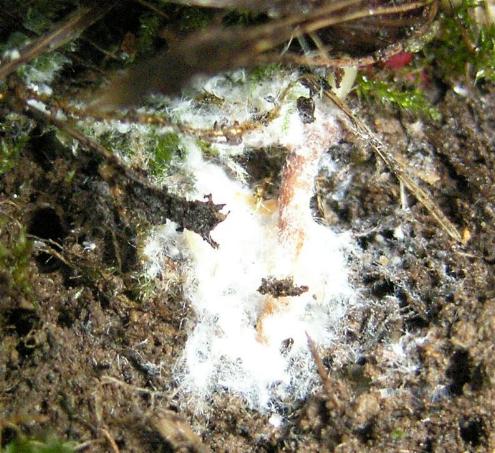
A colony of Root Aphids at the base of a Creeping Buttercup plant.
| HOME | SITEMAP | SEARCH | ARTICLES |
Some of the many species of aphids attack the roots of plants and these can stunt the growth or even kill them, if the infestation is large enough. They are usually associated with particular plants or groups of plants.
Root aphids have a similar life-cycle as 'normal' aphids so some live on two plants, eg. the Sugar Beet Root Aphid starts the seasonal cycle on poplar leaves when the females hatch from overwintering eggs, then cause a gall to form in which she gives birth to many winged, female young which move to beet roots to continue the cycle with several more generations in a season. These summer forms produce a white, waxy material characteristic of most root aphids, and this can often be mistaken for beneficial mycorrhizal fungi. They reproduce asexually.
The Sugar Beet Root Aphid, Pemphigus betae attacks sugar beet, beetroot, swiss chard and weeds such as Fat Hen. Lettuce are prey to Pemphigus bursarius
In the autumn a generation of winged aphids are produced which fly back to the poplar tree and these give birth to wingless males and females which mate to produce the overwintering eggs to complete the cycle. some of theThe Cabbage Root Aphid, Pemphigus populitransversus attacks brassica crops and has a similar life cycle to Pemphigus betae as it uses poplar trees as its primary host.
The Coniferous Root Aphid, Pachypappa tremulae can cause damage to conifer trees, particularly when grown in pots. Again the primary host is on trees in the poplar family.
The Root Aphid on the right is barely recognizable with its coating of white, waxy crystals.The pictures of root aphids on this page were found at the base of Creeping Buttercup plants, but they do not seem to cause much damage judging by the number and vigour of these weeds in my garden!
Treatments
Root Aphids are usually more of a problem to commercial growers of crops or nursery stock. Treatments can be applied after an infestation is detected.
*Imidacloprid is a neonicotinoid compound and these have been suggested as as causative agents of colony collapse disorder (CCD) in Honeybees.
Back to GARDEN CREATURES